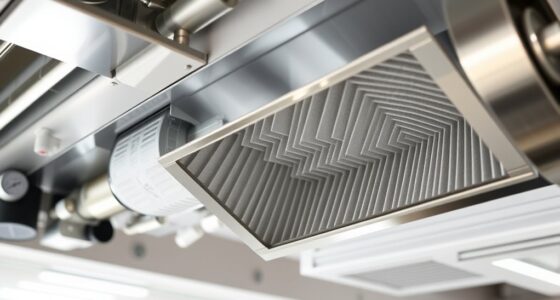Choosing between ISO 16890 and MERV depends on your needs. ISO 16890 provides a global standard focused on how well filters remove particles like PM1, PM2.5, and PM10, making it ideal for worldwide comparison. MERV ratings, mainly used in the U.S., emphasize performance against specific airborne particles for HVAC systems. Understanding both helps you select the best filter for your environment—continue to explore to find out which standard fits your needs best.
Key Takeaways
- ISO 16890 provides a global standard focusing on particle size-specific filtration efficiency, ideal for international comparisons.
- MERV ratings, developed in the U.S., evaluate filter performance based on specific particle removal, suitable for HVAC system compatibility.
- ISO 16890 emphasizes overall indoor air quality improvement by classifying filters across PM1, PM2.5, and PM10 particles.
- MERV ratings are more familiar within the U.S. and help ensure filters meet specific system requirements.
- Choosing between them depends on whether global standardization (ISO 16890) or system-specific performance (MERV) aligns with your needs.

Have you ever wondered how different air filter rating systems compare? When it comes to choosing the right filter, understanding these standards is essential for maintaining ideal indoor air quality. Both ISO 16890 and MERV are designed to help you evaluate filtration efficiency, but they do so in different ways. Knowing the nuances can help you select a filter that best suits your needs, whether it’s for a residential home, office, or industrial space.
ISO 16890 is a globally recognized standard that classifies air filters based on their ability to remove particles from the air, specifically focusing on particulate matter sizes like PM1, PM2.5, and PM10. This system provides an extensive picture of a filter’s performance across a broad spectrum of particle sizes, making it easier to compare filters internationally. When you look at an ISO 16890 rating, you get a clear idea of how effectively the filter enhances indoor air quality by capturing fine particles that can impact health and comfort. Filtration efficiency is measured in terms of the percentage of particles a filter can trap at different sizes, which directly influences the air you breathe daily.
ISO 16890 classifies filters by their ability to remove particles like PM1, PM2.5, and PM10 globally.
On the other hand, MERV, or Minimum Efficiency Reporting Value, is a rating system developed in the United States that assigns a number from 1 to 20 to indicate a filter’s ability to trap particles. Higher MERV ratings mean better filtration efficiency, especially for smaller particles. For example, a MERV 13 filter can considerably reduce airborne particles like pollen, pet dander, and bacteria, improving indoor air quality greatly. However, MERV ratings are more relative, focusing on the filter’s performance against specific particle sizes, rather than providing a universal standard. This can sometimes make it tricky to compare filters from different manufacturers unless you know their corresponding filtration efficiencies.
While both standards aim to guide you in selecting effective air filters, ISO 16890 offers a more consistent global framework, emphasizing particle size and filtration efficiency across a wider range. MERV ratings are more familiar in the U.S. and are often used in HVAC systems to ensure compatibility and performance. Your choice depends on what’s more relevant for your environment—if you need a globally comparable standard, ISO 16890 is a solid choice; but if you’re working within the U.S. and want specific filtration performance details, MERV ratings provide valuable insights. Ultimately, understanding these systems helps you make informed decisions to improve indoor air quality and ensure your filtration system operates at peak efficiency.
Frequently Asked Questions
How Do ISO 16890 and MERV Ratings Impact Indoor Air Quality?
You should know that ISO 16890 and MERV ratings directly impact your indoor air quality by guiding effective air filtration. Higher ratings mean better removal of indoor pollution, reducing allergens, dust, and harmful particles. By choosing filters aligned with these standards, you enhance air cleanliness and health. This ensures your space stays safer and more comfortable, especially if you or your family are sensitive to indoor pollutants.
Can Air Filters Meet Both ISO 16890 and MERV Standards Simultaneously?
It’s quite possible for air filters to meet both ISO 16890 and MERV standards simultaneously, provided they’re designed for filter compatibility with these certification standards. Manufacturers often create filters that target different filtration efficiencies, aligning with both standards. When selecting filters, check the product specifications to guarantee they meet the necessary certifications, so you get peak filtration performance without compromising compatibility or air quality.
Are There Specific Industries That Prefer ISO 16890 Over MERV?
You’ll find that industrial applications often prefer ISO 16890 because it offers more thorough testing for a wider range of particles, ensuring better air quality control. Conversely, residential preferences lean toward MERV ratings, as they’re simpler and suit everyday needs. ISO 16890’s detailed classification appeals to industries needing strict filtration standards, while homeowners typically choose MERV for its convenience and effectiveness in common indoor environments.
How Do Maintenance Requirements Differ Between ISO 16890 and MERV Filters?
You’ll find that maintenance requirements differ between ISO 16890 and MERV filters mainly in filter lifespan and maintenance frequency. ISO 16890 filters often have a longer lifespan, reducing how often you need to replace them, which lowers maintenance frequency. MERV filters may require more frequent checks and replacements due to their design and filtration efficiency. Regular inspections guarantee maximum performance and indoor air quality, regardless of the standard you choose.
What Are the Cost Implications of Choosing ISO 16890 Versus MERV Filters?
Choosing ISO 16890 filters may cost more upfront, but they often last longer and provide better air quality, potentially saving you money over time. MERV filters usually have lower initial prices, fitting tighter budgets. Your decision depends on your budget considerations and long-term needs. If you prioritize higher efficiency and durability, investing in ISO 16890 filters could be more cost-effective in the long run.
Conclusion
Choosing between ISO 16890 and MERV is like picking the right key to access fresh indoor air. Think of ISO 16890 as a versatile Swiss Army knife, offering a broader view of filtration efficiency, while MERV is your trusted compass, guiding you through specific needs. By understanding their differences, you can navigate the air quality landscape with confidence, ensuring your space feels as invigorating as a cool breeze on a warm day. Keep the right filter, and breathe easy!










